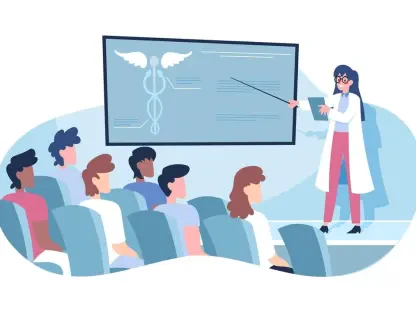Faisal Zain is a highly respected healthcare expert with a specialized focus on medical technology. His deep involvement in the manufacturing of medical devices has positioned him at the forefront of innovation in diagnostics and treatment. Today, he brings his expertise to a critical topic: the public health crisis driven by wildfire smoke, an issue exacerbated by climate change. This interview explores the multifaceted impact of wildfires on health, particularly focusing on vulnerable populations and the importance of systemic change.
What motivated you to focus on the public health crisis related to wildfire smoke?
The sheer scale and frequency of wildfires in recent years have made their impact impossible to ignore. I’m motivated by the urgent need to understand how wildfire smoke affects communities, especially those already vulnerable. Climate change has made these fires more intense, necessitating a closer look at their public health implications.
How has the frequency and intensity of wildfires changed over the years?
Over the past few decades, we’ve seen a dramatic increase in both the size and intensity of wildfires, largely due to climate change and poor forest management. The seasons now stretch longer, with fires recurring in places previously unaffected. This pattern has essentially turned them into a year-round phenomenon rather than a seasonal threat.
Can you explain what PM2.5 is and why it’s particularly harmful?
PM2.5 refers to tiny particles in the air that are less than 2.5 micrometers in diameter. They’re especially harmful because they can bypass our usual biological defenses, such as the nasal passage, and penetrate deep into the lungs. From there, they can enter the bloodstream, leading to a range of health issues including respiratory diseases and even cardiovascular problems.
How does exposure to PM2.5 affect the human body in the short term and long term?
In the short term, exposure can cause immediate respiratory issues like coughing and difficulty breathing. Over the long term, repeated exposure can contribute to more serious conditions like chronic respiratory diseases, cardiovascular harm, and even adverse neurological effects due to the fine particles penetrating deeper into the body.
Why is exercising outdoors during smoky conditions more harmful than usual?
Exercising increases respiratory activity, meaning you breathe faster and deeper, pulling more polluted air into your lungs. During smoky conditions, this can drastically increase your exposure to harmful particulates, making what would normally be a healthy activity potentially hazardous.
Are there specific AQI thresholds where outdoor exercise becomes dangerous?
Yes, even when the AQI is in the “moderate” range, particularly sensitive individuals might start experiencing adverse effects. Once AQI values exceed 100, it becomes increasingly hazardous for sensitive groups and generally unsafe for prolonged outdoor activity for anyone.
Which groups are most affected by poor air quality due to wildfires?
Vulnerable populations, including outdoor workers, children, the elderly, and those with pre-existing health conditions, are most at risk. Economic factors also play a role, as low-income communities may not have access to protective resources like air filters or the ability to modify work schedules or locations.
How is this issue both a public health and an equity problem?
The inequity lies in the fact that not everyone has equal access to mitigation tools or the information necessary to protect themselves. Communities with fewer resources and lower socio-economic statuses often bear the brunt of pollution-induced health issues, which highlights the need for policies addressing both health and equity.
What are some immediate steps individuals can take to protect themselves from wildfire smoke?
Regularly checking the AQI and moving exercise indoors during poor air quality is important. Using HEPA filters, sealing home leaks, and advocating for community measures to improve air quality can significantly reduce exposure on smoky days.
How effective are personal precautions like using HEPA filters or checking AQI regularly?
These precautions can be very effective on an individual level, helping to reduce personal exposure to harmful particles in the air. While they don’t solve the broader issue, they play a critical role in minimizing personal health risks.
Why is personal action not enough to solve this crisis?
While individual actions can mitigate personal risk, the root causes of wildfires—like climate change—require systemic policy and investment changes. Only through collective action and large-scale initiatives can we reduce the occurrence and impact of these fires.
What are some key areas where investment and policy change are crucial?
Investment in renewable energy, sustainable forest management, and robust public health infrastructure is vital. Policy changes should also focus on enhancing climate resilience for vulnerable communities to cope with increasing wildfire frequencies.
How does climate justice intersect with the health impacts of wildfire smoke?
Climate justice emphasizes addressing the disproportionate impact environmental issues have on marginalized communities. In the context of wildfires, it means designing health interventions and long-term strategies that prioritize these affected populations, ensuring they have the necessary resources to adapt and safeguard their health.
Why is it important to focus on climate resilience strategies for frontline communities?
Frontline communities are often the first and hardest hit by climate-related issues, including wildfires. Building resilience in these areas means creating systems that can withstand and recover from these impacts, ensuring public health and safety in an increasingly volatile climate.
How has the perception of air quality alerts changed in recent years?
Air quality alerts are becoming more frequent and normalized, which is concerning. Instead of being rare events signaling immediate action, they are now a regular part of life. This shift highlights the urgency for both awareness and action.
What is your message to policymakers and the public about addressing this issue urgently?
We must prioritize clean air as a fundamental right. Policy makers and the public need to collaborate on sustainable solutions that address the root causes, while simultaneously developing adaptive strategies to deal with the immediate challenges posed by wildfire smoke and climate change.
How has living in Denver influenced your perspective on this issue?
Living in Denver, where air quality can fluctuate dramatically, has made the impacts of wildfire smoke personal. It’s a consistent reminder of why addressing air quality is crucial not just for health, but for equitable living conditions.
Can you share more about your background in environmental and behavioral health and how it informs your work?
My work in environmental and behavioral health has underscored the interconnectedness of humans and their environment. By understanding behavioral responses to environmental risks, I aim to contribute to solutions that empower individuals and communities to lead healthier lives in the face of these challenges.
Where can people find more of your writing and insights on this topic?
For those interested in delving deeper, they can follow my work on platforms like Substack under ‘Thrive With You’ or connect with me on LinkedIn. These resources are designed to offer ongoing insights and strategies for both personal and public health improvements related to environmental challenges.
How can individuals get more involved in advocating for cleaner air and better forest management practices?
Engaging with local community groups focused on environmental advocacy is a great start. Additionally, contacting policy makers and participating in public discourse on sustainable practices can help drive legislative and community action toward better air quality and forest management.









